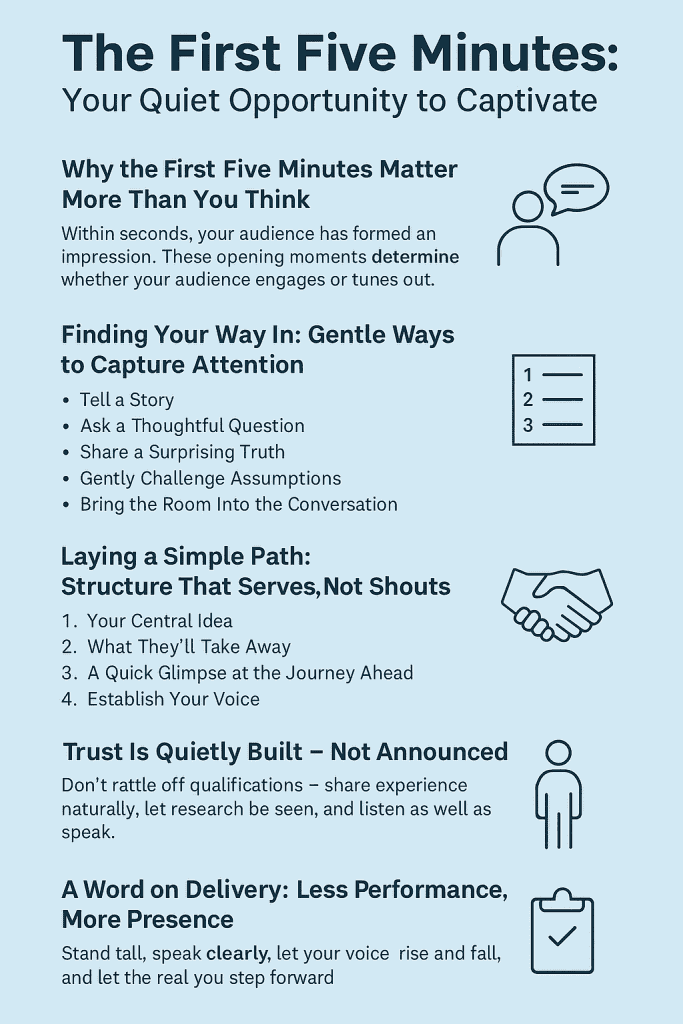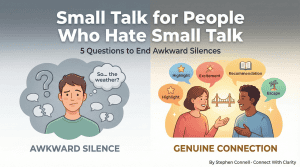There’s something quietly heroic about stepping up to speak. Whether it’s a boardroom or a village hall, those first five minutes—often overlooked or underestimated—carry the weight of everything that follows.
You might think of it as a short sprint. In truth, it’s more like stepping onto a narrow ridge path, the kind you’d find in the Highlands, where the footing is uncertain, but the view, if you get it right, is breathtaking.
These opening moments are not about natural talent. They’re about presence. Preparation. And learning to captivate your audience not with performance, but with purpose.
Why the First Five Minutes Matter More Than You Think
The moment you enter a room—before you’ve even said a word—judgements begin. We’re all guilty of it. We look for signs: confidence, clarity, warmth.
Audiences do the same. Within seconds, they’ve decided whether you’re worth listening to. It’s not vanity—it’s biology. We’re wired to scan for connection and relevance.
That’s why your opening isn’t just the start. It’s your chance to offer your hand, to guide your audience through unfamiliar terrain and help them feel safe in your company.
Finding Your Way In: Gentle Ways to Capture Attention
You don’t need to dazzle. Just anchor your words in authenticity. Here are a few ways to begin that feel honest, human, and effective:
- Tell a Story – Real stories have power. They ground your message in something tangible. I remember once watching a man speak about resilience. He began with a story about a wild pony stuck on a cliff edge in Dartmoor. Not dramatic—just real. It stayed with me.
- Ask a Thoughtful Question – “What would your week look like if you worked one day less?” It’s not provocative for the sake of it. It invites reflection. And reflection is the first step toward engagement.
- Share a Surprising Truth – “Every 30 seconds, there’s a cyberattack somewhere in the world.” Startling? Yes. But if it relates directly to your message, it’s the jolt that wakes curiosity.
- Gently Challenge Assumptions – “We’re told multitasking makes us efficient. But what if focus is the real secret?” You’re not confronting; you’re exploring an alternative path together.
- Bring the Room Into the Conversation – “I know many of us here today are adapting to new technology…” This signals relevance. It’s not just your presentation anymore—it’s our moment.
Whatever approach you choose, be genuine. Speak not at your audience, but with them. You’re not performing a monologue—you’re beginning a conversation.
Laying a Simple Path: Structure That Captivates, Not Shouts
In the wild, the best trails are the ones you hardly notice. They guide without fuss, with just enough markers to reassure you that you’re heading the right way.
The same is true of a good five-minute talk. Here’s a gentle structure that works:
- Your Central Idea – Not just your topic, but why it matters. “I’m here to share how a four-day working week could change not just business, but wellbeing.”
- What They’ll Take Away – Clarify what the next few minutes are about. “We’ll explore the benefits, the barriers, and how you can make it work.”
- A Quick Glimpse at the Journey Ahead – Outline your three key points. No more than three. That’s the golden number—memorable, manageable, meaningful.
- Establish Your Voice – A sentence about who you are and why this matters to you. “I’ve spent the last decade working with teams that trialled new ways of working. What I’ve seen changed how I live and lead.”
Your slides, if you’re using any, should follow this same calm approach. Minimal words. Honest visuals. Let them support your voice, not replace it.
Trust Is Quietly Built—Not Announced
People don’t believe you just because you say you’re credible. They believe you because you’re clear, you’re prepared, and you seem to care.
So instead of rattling off your CV, just show your grounding. Mention your experience naturally. Let them see the research behind your claims. And—this matters—listen as much as you speak.
Trust is built in eye contact, open posture, and a well-placed pause. It’s in the small, unseen moments. Like catching someone’s eye when you tell a story. Or nodding in response to a smile.
A Word on Delivery: Less Performance, More Presence
This isn’t theatre. It’s a human connection.
Stand tall, but not stiff. Speak clearly, but as if you were explaining something over a walk. Use your hands when they help. Smile when it feels right. Don’t force it.
Look at your audience—not in one sweeping scan, but gently, from face to face. Let your voice rise and fall like conversation, not like a script.
Above all, let the real you step forward. Not a polished version. Not the “stage you.” Just the one that knows the topic, cares about it, and wants to share it.
A Few Traps to Avoid (Gently Spoken Advice)
- Don’t open with an apology. It undermines you before you’ve begun.
- Don’t read word for word. Speak from understanding, not from paper.
- Don’t fill your slides with text. The fewer words, the stronger they are.
- Don’t forget your audience. Speak to their needs, not just your own.
- Don’t be afraid of silence. It often carries more weight than word
Practice Not to Perform—But to Feel Ready
You don’t need to memorise every word. But do rehearse out loud. Record yourself. Watch it back with kindness. Note where you rush, where you shine.
Practice isn’t about perfect delivery. It’s about arriving at the moment feeling grounded, not guessing.

Your Opening Is a Doorway
And every doorway invites a journey.
If you walk through with intention—with warmth, clarity, and care—your audience will follow. They won’t remember every word, but they’ll remember how you made them feel. That you respected their time. That you had something worth saying.
That’s the mark of a true communicator.
So take a breath. Open strong. And trust that what you’ve built in those first five minutes is enough to carry the room forward.




